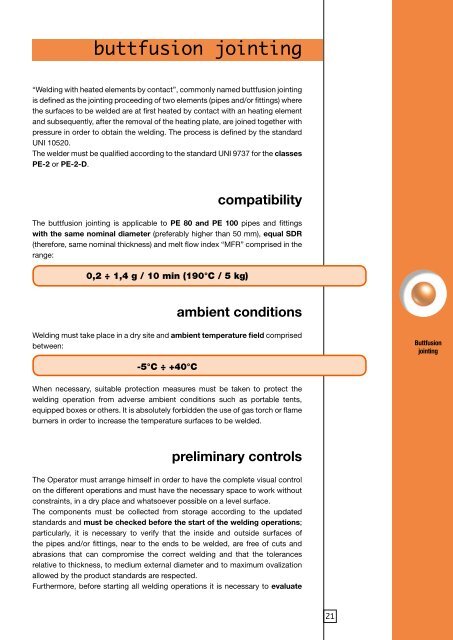TECHNICAL MANUAL - Sharq.biz
TECHNICAL MANUAL - Sharq.biz
TECHNICAL MANUAL - Sharq.biz
You also want an ePaper? Increase the reach of your titles
YUMPU automatically turns print PDFs into web optimized ePapers that Google loves.
uttfusion jointing“Welding with heated elements by contact”, commonly named buttfusion jointingis defined as the jointing proceeding of two elements (pipes and/or fittings) wherethe surfaces to be welded are at first heated by contact with an heating elementand subsequently, after the removal of the heating plate, are joined together withpressure in order to obtain the welding. The process is defined by the standardUNI 10520.The welder must be qualified according to the standard UNI 9737 for the classesPE-2 or PE-2-D.compatibilityThe buttfusion jointing is applicable to PE 80 and PE 100 pipes and fittingswith the same nominal diameter (preferably higher than 50 mm), equal SDR(therefore, same nominal thickness) and melt flow index “MFR” comprised in therange:0,2 ÷ 1,4 g / 10 min (190°C / 5 kg)ambient conditionsWelding must take place in a dry site and ambient temperature field comprisedbetween:-5°C ÷ +40°CButtfusionjointingWhen necessary, suitable protection measures must be taken to protect thewelding operation from adverse ambient conditions such as portable tents,equipped boxes or others. It is absolutely forbidden the use of gas torch or flameburners in order to increase the temperature surfaces to be welded.preliminary controlsThe Operator must arrange himself in order to have the complete visual controlon the different operations and must have the necessary space to work withoutconstraints, in a dry place and whatsoever possible on a level surface.The components must be collected from storage according to the updatedstandards and must be checked before the start of the welding operations;particularly, it is necessary to verify that the inside and outside surfaces ofthe pipes and/or fittings, near to the ends to be welded, are free of cuts andabrasions that can compromise the correct welding and that the tolerancesrelative to thickness, to medium external diameter and to maximum ovalizationallowed by the product standards are respected.Furthermore, before starting all welding operations it is necessary to evaluate21


